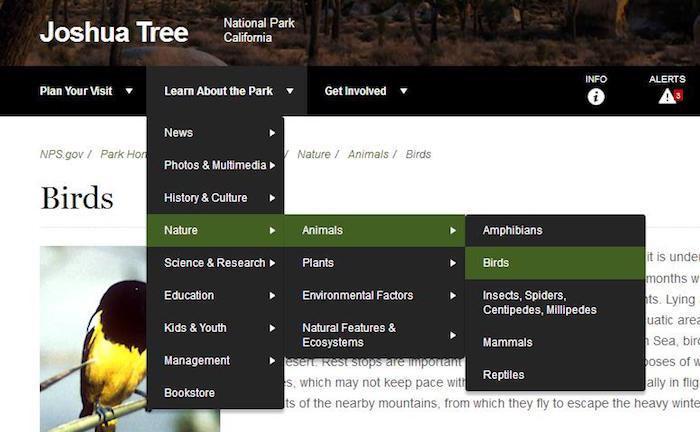
Knowing that the Phainopepla shows up in Joshua Tree National Park during winter months can better prepare you for a birding outing in the park/Kirby Adams
Proper preparation often makes the difference between merely seeing some good birds and coming home with a trip list bursting at the seams and a few lifers to boot. It’s easy to enjoy a birding trip without studying your field guides and knowing your geography, but to many birders the prep is half the fun.
It’s no secret that you need to know which birds are likely in an area and what their habits are. If you’re at Joshua Tree National Park in the winter, you aren’t going to be looking for Atlantic Puffins. The striking Phainopepla is more likely to be on your list of targets. This bird is a denizen of the Southwestern deserts that acts like a traditional flycatcher despite being in its own, not-so-closely related family known as the silky-flycatchers. In winter, your preparation will tell you that you can find the Phainopepla close to Desert Mistletoe, defending the precious berries against House Finches and anyone else that wants a juicy treat. Find the mistletoe and you’ve found a spot where you can observe Phainopepla behavior all day. Otherwise, you might catch only a fleeting glimpse of a glossy black bird flying past. The lucky birder who got all those close-up photos you saw online after your trip wasn’t really lucky – she was prepared.
With that in mind, it’s important to remember one of the best sources of birding information at the national parks – the National Park Service itself!
With surveys showing that many millions of Americans enjoy watching birds, the parks make a point of presenting information about birds and birding. The recent redesign of NPS websites makes getting to the bird info easy. There’s usually a drop-down menu headed “Learn About the Park.” From there, you select “Nature,” then “Animals,” and finally “Birds.” Most of the parks have a dedicated bird page. Information on conservation of endangered or threatened birds is usually in here, along with mention of some of the park’s iconic birds and where to find them. Sometimes, as with Yosemite National Park, results of recent Christmas Bird Counts are touted on the birds page. If the park is proud of something bird related, chances are good that it’s worth your time to check it out when you visit.
Who is it that’s proud of the birding and conservation at any given park? It’s the rangers, biologists, staff, and volunteers. These people are your point of contact for all things park-related, including birds. Not every ranger you run into is going to be a birder, but they most likely still know a couple secrets about finding birds.

National park websites can offer good information for birders, although not all park websites are created equal/NPS
I’ve had helpful rangers apologize for not being bird experts right before giving me detailed information about when the flocks of Brown-headed Nuthatches move through the Visitor Center grove at Congaree National Park and how best to spot a White-tailed Ptarmigan from Medicine Bow Curve on Trail Ridge Road in Rocky Mountain National Park. Rangers in Olympic National Park gave me pointers on hotspots to see waterfowl that weren’t even part of the park.
Sometimes the ranger actually is a world-class birder. Sharon Stiteler, known in the birding world as “Birdchick,” is a part-time ranger at Mississippi National River and Recreation Area in Minnesota. If you find yourself watching a heron rookery on the Mississippi River with Ranger Stiteler, you’ve been birding with a bird celebrity.
Park biologists aren’t often celebrities, but if they work with birds, there’s a good chance they identify as birders to some degree. Because they know their birds, these people are a birder’s best friend when it comes to intel on a park and the surrounding area.
This was the case last week in northern Michigan when Pictured Rocks National Lakeshore wildlife biologist Cindy Heyd set the Michigan birding scene on fire. Heyd has been with the National Park Service in places as diverse as Badlands National Park and Ocmulgee National Monument in Georgia. She surely wasn’t expecting to see a Crested Caracara on the shore of Lake Superior, but she spotted it across the street from the park (literally) and got the word out.
Michigan birders have an NPS biologist to thank for what’s sure to be accepted as the first official Crested Caracara record for Michigan.
Study your field guides and monitor eBird, but don’t forgot to use the National Park Service’s resources to prepare for your birding trip. These are your parks, and the staff are there to help the guests, as they’ve been doing for a century now. If bird information is what you want, they’ll find it for you!




 Support Essential Coverage of Essential Places
Support Essential Coverage of Essential Places






